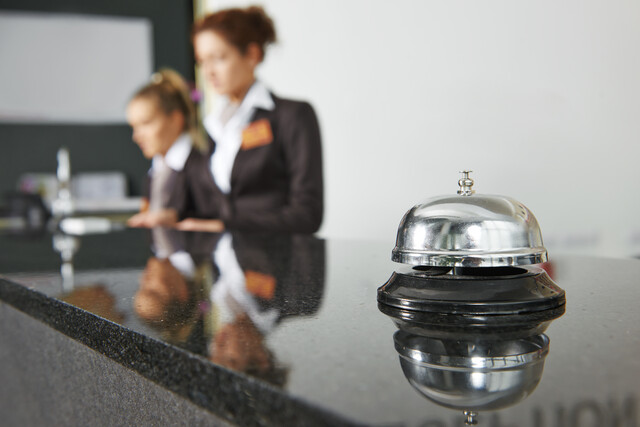As a server, your job is to be a hospitality expert. This requires effort on your part to make your guests or customers feel as welcome and comfortable as possible. I interviewed a long-time waitress at a fine dining establishment and asked her questions about special situations that crop up during the course of an evening. The following is an interview with Berta, a very experienced waitress at a fine dining Italian restaurant.
Me: What do you consider to be the most important skill a waitress needs in order to be wildly successful?
Berta: You have to learn The Dance.
Me: The Dance?
Berta: That is the best way I know how to describe what it is that I do every night. Every waitress has to know her job: That means she knows the restaurant, the menu, what goes into the dishes, how they're prepared, how to pair them with the wine. The other part of her job is to know how to read the people.
Me: How is your restaurant different from eating in a diner or family restaurant?
Berta: At a diner or a family restaurant, your customers are looking for good food, quick service, and maybe some pleasantries, but not too much. Most of the time they want to get in, get fed, and get out. In a fine dining environment, the customer expects so much more. They know they're going to pay more for the meal, and they plan to take their time. In a fine dining environment, most of your customers expect to be pampered, catered to, entertained: This is The Dance.
Me: I'm still not sure exactly what you mean by The Dance.
Berta: The Dance is what your patrons expect from the moment they walk through the door of the restaurant. Someone greets them instantly and makes them feel special. There is a certain amount of ceremony as they are taken to their table and given menus. Every customer here gets an aperitif of vermouth with a twist of lemon as they look at the menu. Immediately they are pampered with this complimentary cocktail. Even the ones who do not care for vermouth appreciate the gesture.
Me: What if they prefer something other than vermouth?
Berta: That's part of The Dance. They know the vermouth is complimentary, so when I ask what else I can bring to drink, some will ask for iced tea or water, but the others will order their martini, or cosmo, or whatever.
Me: I have a particular question regarding customers dining with children. How do you handle that? Most servers dread customers with kids.
Berta: Before I learned The Dance I used to cringe, too, when parents came in with their kids.
Me: Why is that?
Berta: Most parents are on edge when dining with their kids and they send that message to the kids, who then usually do act up.
Me: How can you change the dynamics like that if they're already into it?
Berta: I will approach the table and I will treat the parents as if they are visiting royalty, or celebrities of some kind -- that they're people worthy of my notice. It used to be I would look down on parents with children, and then the parents will act uncomfortable and guilty if their kids are acting up; the kids sense this and they just keep getting worse.
So, instead, I give the parents my undivided attention, repeat their orders back to them in great detail, forcing them to look at me. Then I make sure that I compliment them on their choice of meal, informing them what they can expect from tasting the dish. By talking to the adults on a higher level, they begin to respond to me on a higher level. Then they expect their kids to act better, and usually they do.
Then I talk about wine choices, and for this situation I do a flight of wine tastings. I bring at least three wine tasters for each parent, have them taste the wine, then we will discuss the attributes of each wine as they taste it, have them consider whether it would be a good pairing with the meal that they have chosen. Pretty soon, the kids begin to notice that they are being left out, that my attention is 100 percent on their parents. The kids figure out pretty fast that if they want my attention, they will get it by acting like a lady or a gentleman. Now, I just ignore bad behavior.
Serving customers with children can be a challenge. There are several things for you to remember:
� You are not their parents.
� You are not their babysitter.
� You are to provide food quickly.
� You are to be polite to the kids.
Keeping Kids Occupied:
Some restaurants have kids' menus that are interactive; the restaurant provides crayons and an interactive menu so the kids have something to do. Others even have small books or toys to give to the customers who dine with children. Some waiters even take it upon themselves to give the kids a complimentary serving of bread so they have something to do with their hands. Kids are also unaware of their hunger until they smell the food around them, and then they really are hungry. By giving them something to do, and possibly providing a bread basket to take away some of the sharpest hunger pangs, the kids will act a little better.
Crackers and Speedy Service:
Some establishments frown on giving away bread baskets or bread boards until they know what the parents are going to order. If your restaurant is on such a shoestring budget, you can still try to help the family handle the immediate hunger of their children by bringing crackers to the table. Again, this gives them something to do, and it also puts a little something in their stomach. Secondly, for parties with children, it is sometimes in your best interest to put their order in as quickly as possible. You want to minimize the amount of time the kids are sitting there with nothing to do, their stomachs grumbling, and hurting because they are so hungry.
It is also critical that you get the drinks to the table as quickly as possible as well. Anything that will keep the kids occupied will earn you the gratitude of the parents. You are not a babysitter, but anything you can to do help the parents have a more relaxing meal will be appreciated by your patrons. Perhaps you can even bring a small bowl of maraschino cherries to the table and allow the children to use tongs to serve themselves a cherry garnish.
Lastly, keep your bad attitude to yourself. Learn to read children as well as you learn to read adults. Treat the kids as human beings; be polite to them. You will attract more of their parents' patronage, and as the kids get to you know you from visit to visit, they will prefer to get your attention with good behavior rather than bad. Some waitresses have found that by complimenting the children on their good behavior and ignoring their inappropriate behavior the child automatically improves his or her behavior. This is considered to be a positive feedback system, and many corporations are learning that this is particularly effective, even when dealing with adults. Try it as an experiment and see how the kids behave.
Kids' Meals and Menus:
Any restaurant that expects to be serving children really needs to have a kids' menu, or a section of the menu that is specifically targeted at the children. Have kid-friendly items on it like grilled cheese, or macaroni and cheese.
If you do not have a kids' menu, then direct their attention to the appetizer section of the menu. Often, an appetizer is just the right size, and usually kids will try something new if it looks good and appealing and sounds interesting.
Multiple Tables:
Serving multiple tables is a fact of life when you are serving. Rarely do you have the luxury of giving your undivided attention to a single table at a time. You really do not want to do this very often, as your tip for that period of time is totally dependent on one table.
Handling multiple tables is easy if you develop a good relationship with the rest of the staff. Everyone who works in a restaurant is part of the entire team whose job it is to serve your customers. As the server, you have the bulk of the responsibility, but as you get really busy, you will need to learn to ask your bussers and expediters to help you to get drinks, refills, and take food out to table two, while you handle the order for table four. Berta refers to this as part of The Dance, as well, but this part of the dance is restricted to the staff of the restaurant.
As you become more comfortable with your abilities, you will be able to serve multiple tables with ease. One of the waitresses I interviewed has a very set system. She works the breakfast shift in a diner, and about half of her customers are regulars, and she has learned what they usually order. She will bring their coffee to the table, and ASK if they want their usual. Even though she knows it, she still asks, as every now and then people are known to change their habits. She then works her section systematically so all her customers are served, drinks refilled, asked if their meal is to their satisfaction, etc. She has mastered the art of multiple tables, and most of her customers see that she is giving full effort to all of her tables, so they do not complain, because they can see her system.
The very essence of waiting tables is coming into contact with people. All of us know that people can have good and bad moods, and the restaurant industry this is no exception. Some people will be angry and upset from the moment they arrive at your establishment. Your job is to serve them as quickly and as efficiently as possible. And if they continue to be grumpy, you want them to finish quickly, so that they leave and do not ruin the experience for the rest of your patrons.
If your customer is unhappy because of a mistake either you, or the kitchen made, it is your responsibility to fix that mistake. Take the responsibility for the mistake. Never blame someone else for your mistake. Your patrons are smart, and they are observant. I was once in a restaurant where the cashier had taken a to-go order over the phone and made a mistake on the order. After she had taken care of the problem with the customer, her manager came up to her and asked why she didn't just say the kitchen had made the mistake. I was shocked to hear this kind of advice coming from a manger. I was even more appalled that he said it out where customers could hear him. His lack of integrity has now been advertised to the restaurant in general. The cashier told him she took responsibility for the mistake because it was her fault. If I were looking for someone to hire, I would approach that cashier and not that manager.
If your customer persists in being dissatisfied with something about their experience in your establishment, it is up to you to offer a complimentary appetizer, or dessert, or after-dinner coffee to help smooth things over. Usually, when people get something extra, they are appeased and look no further.
From time to time, you will have a customer who refuses to be satisfied no matter what you try. At this point, you either cut your losses or get your manager, if that is what your patron requests. There will be times when you have an unhappy customer that no amount of appeasement will help. Then, it is probably in everyone's best interest to get them served and done as quickly as possible.
When to Get the Manager Involved:
The manager is there to handle any large disputes. That is what they get paid for. The manager can also act as a bouncer if your patron becomes inebriated or threatening. Also, if your entire establishment really works as a team, getting the manager involved is not a black mark against you. Usually your manager does know how things have been going with your tables, and that you have a very unhappy customer who refuses to be pacified. Your manager usually has more customer service experience than you do, so allow him or her to handle your unhappy customer and move on to your other patrons.
There will be times, too, when your manager has to handle other situations that have nothing to do with you. From time to time, you will have a customer who has simply had too much to drink, and all your efforts have been in vain to get him to stop drinking. It is time to get your manager involved.

























